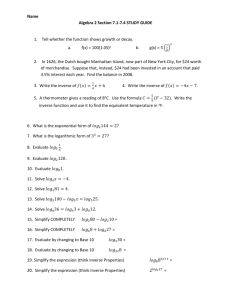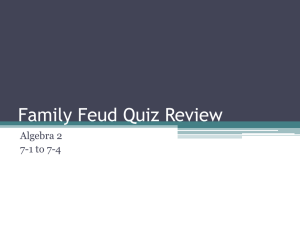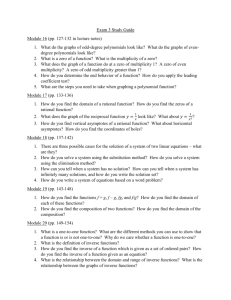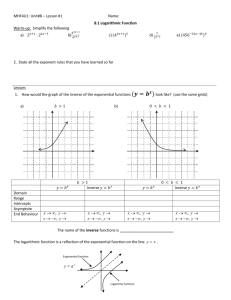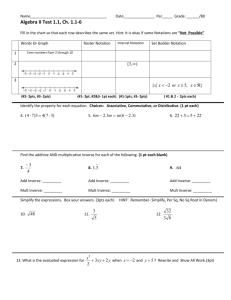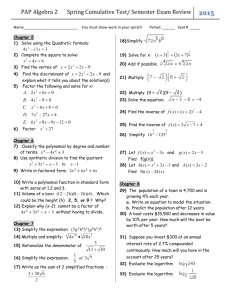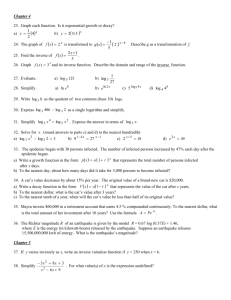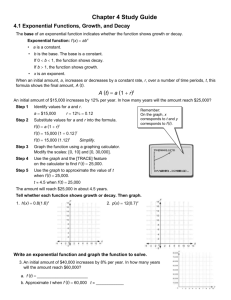Honors Algebra II Final Examination Review 2014 Mrs. Bowe and
advertisement
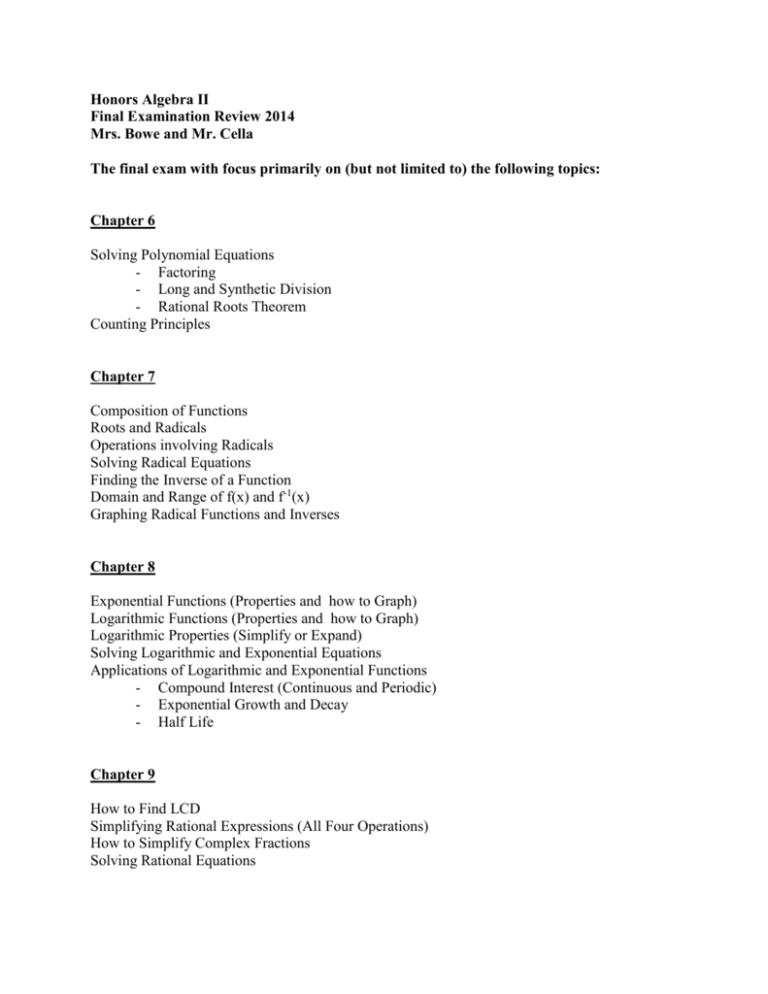
Honors Algebra II Final Examination Review 2014 Mrs. Bowe and Mr. Cella The final exam with focus primarily on (but not limited to) the following topics: Chapter 6 Solving Polynomial Equations - Factoring - Long and Synthetic Division - Rational Roots Theorem Counting Principles Chapter 7 Composition of Functions Roots and Radicals Operations involving Radicals Solving Radical Equations Finding the Inverse of a Function Domain and Range of f(x) and f-1(x) Graphing Radical Functions and Inverses Chapter 8 Exponential Functions (Properties and how to Graph) Logarithmic Functions (Properties and how to Graph) Logarithmic Properties (Simplify or Expand) Solving Logarithmic and Exponential Equations Applications of Logarithmic and Exponential Functions - Compound Interest (Continuous and Periodic) - Exponential Growth and Decay - Half Life Chapter 9 How to Find LCD Simplifying Rational Expressions (All Four Operations) How to Simplify Complex Fractions Solving Rational Equations Chapter 6 Sample Problems 1. Write a polynomial in standard from with zeros 5, -4, and 1. 2. Find P(2) using synthetic division for 𝑃(𝑥) = 𝑥 3 + 𝑥 + 7. 3. Divide (𝑥 3 + 4 − 11𝑥 + 3𝑥 2 ) ÷ (6 + 𝑥) 4. Solve via Graphing:𝑥 2 + 7𝑥 = 19 5. Solve for x: 𝑥 3 − 512 = 0 6. Solve for x: 𝑥 4 − 34𝑥 2 = −225 7. Find the roots: 𝑥 3 − 2𝑥 2 + 10𝑥 + 136 = 0 8. Find the roots: 𝑥 4 − 5𝑥 3 + 11𝑥 2 − 25𝑥 + 30 = 0 9. In how many different orders can you line up 8 cards on a shelf? 10. 10! 7! 3! 4!3! 7C6 60C3 15C3 11. There are ten students participating in a spelling bee. In how many ways can the students who go first and second in the bee be chosen? 12. The Booster Club sells meals at basketball games. Each meal comes with a choice of hamburger, pizza, hotdog, cheeseburger, or taco and a choice of root beer, lemonade, milk, coffee, tea, or cola. How many combinations are there? 13. The volume in the cubic feet of a box can be expressed as 𝑉(𝑥) = 𝑥 3 − 6𝑥 2 + 8𝑥 = 0. The width of the box can be written as 2 − 𝑥. a) Factor the polynomial b) Describe the realistic domain c) What is the maximum volume of the box? Chapter 7 Sample Problems True or False: 3 1. In the expression √𝑥, √ is called the radicand. 3 2. In the expression √𝑥, 3 is called the index 3. The conjugate of −3 − √2𝑥 is 3 + √2𝑥 3 3 4. √82 can be written as 82 1 1 1 5. 23 ∙ 43 = (2 ∙ 4)3 2 6. (√𝑎 + √𝑏) = 𝑎 + 𝑏 2 1 1 1 −1 7. 43 ∙ 43 = 4 + 4 8. (𝑎 + 𝑏) =𝑎+𝑏 9. Simplify each radical expression. Use absolute values when needed. 3 4 a) √−729𝑥13 𝑦 4 4 c) √81𝑥12 𝑦 36 b) √361𝑥 7 𝑦 9 4 d) √256𝑥14 𝑦 34 10. Simplify each expression. Rationalize all denominators. a) √300𝑎𝑏 5 √3𝑎7 𝑏 3 1 b) (7 + 2√3) (7 − 2√3) c) e) √20 − 3√5 + √45 f) 3 √2−3 3 d) √3𝑥𝑦 ∙ √12𝑥 3 𝑦 2− √3 √9𝑥 4 𝑦 4 √6𝑥 3 𝑦2 g) h) √6(1 − √12) 4 √8𝑥𝑦 11. Simplify each expression. 4 3 27𝑠7 𝑡 11 3 3 d) ( 𝑥4 −1 𝑦2 1 b) (81𝑥 8 )−4 a) ( −64𝑠𝑡 2 ) 8 2 1 ) c) (9𝑥 −4 𝑦 2 )−2 1 1 f) (16𝑥 8 )−.75 e) (𝑠 3 𝑡 2 ) (𝑠 2 𝑡 5 ) 12. Solve each equation. Check for extraneous solutions. a) 3 √𝑥 + 5 = 6 d) √𝑥 + 2 − 3 = 2𝑥 g) √−5𝑥−3 √4−2𝑥 =0 1 1 b) √𝑥 − 3 = 𝑥 − 5 c) (2𝑥 + 1)2 = (𝑥 + 11)4 e) √𝑥 2 + 4 = 7 f) 2(𝑥 − 1)3 = 162 4 1 −1 h) (2𝑥 + 1)2 = 3(2𝑥 + 1) 2 Chapter 7 Sample Problems (Continued) Shown below are two functions: h(x) and r(x) (both graphs have x and y scales of 1) A. Determine if the graph’s inverse is a function B. Give the domain of the inverse C. Give the Range of the inverse 13. The graph of h(x) is 14. The graph of r(x) is 15. Which point(s) below cannot be on the graph of 𝑓 −1 (𝑥) if 𝑓(𝑥) = 2𝑥 − 5. A) (15 , 10) B) (3 , 1) C) (-9 , -2) D) (0 , -2.5) 16. Which statement is true about the function 𝑓(𝑥) = 𝑥 2 − 12? I. 𝑓 −1 (𝑥) = ±√𝑥 + 12 II. The range of 𝑓 −1 (𝑥) is 𝑦 ≥ −12 III. The point (-12 , 0) falls on 𝑓 −1 (𝑥). A. I only B. II only C. III only D. I and II only E. I and III only F. II and III only G I, II, and III 17. If 𝑓(𝑥) = 4 − √2𝑥 − 1, and 𝑓(ℎ(𝑥)) = 𝑥, what function defines h(x)? 𝑓(2+ℎ)−𝑓(2) 18. Given 𝑓(𝑥) = 3𝑥 2 − 1, find . ℎ 19. Graph the following functions and state the domain, range, and endpoint. a) 𝑦 = −2√2𝑥 − 4 + 3 b) 𝑦 = √−𝑥 + 2 − 1 f x 2 x2 3 g ( x) 3 x 4 6 k x m x 20. 21. 22. 23. 24. 25. 5x 6 7 2x 1 3 hx x 8 n x 2 3x 12 9 4 2x 5 1 o x 2 4x 1 j x Rewrite j(x) so that it is no longer a complex expression. State the domain and range. Find the inverse of j(x). State the domain and range. Find the inverse of ox . State the domain and range for ox and its inverse. Find f(h(x)). Find n(n(x)). When does n(x) = k(x) Chapter 8 Sample Problems 1. Given the function 𝑓(𝑥) = 3𝑒 −0.2𝑥 + 1. a. Describe the transformation of the basic 𝑒 −0.2𝑥 function in words. b. What is the y-intercept for the basic function? What is the y-intercept for 𝑓(𝑥)? c. Identify any asymptotes for 𝑓(𝑥). d. State the domain and range for 𝑓(𝑥). 2. Given the function 𝑓(𝑥) = 2 − log 3 (4 − 𝑥) a. Describe the transformation of the basic log 3 (𝑥) function in words. b. What is the x-intercept for the basic function? What is the x-intercept for 𝑓(𝑥)? c. Identify any asymptotes for 𝑓(𝑥). d. State the domain and range for 𝑓(𝑥). *Round all answers to two decimal places* 3. Evaluate log 𝑎 (16) given that log 𝑎 2 = 0.4307 4. The common logarithm for a number is 5. What is the number? 5. A certain population decreases according to the equation 𝑦 = 300 − 5𝑒 −0.2𝑡 . Find the initial population. 6. Find the balance in an account after 2 years if $2,500 is deposited at an annual rate of 5% and interest is compounded continuously. 7. An initial deposit of $320 is made into an account which accumulates interest semiannually at a rate of 5.25%. What is the account balance after 5 years? 8. Solve the following for each variable: 4 A. 5𝑦 = 18 B. log 6 80 = 𝑦 C. log 𝑥 = −3 D. log 𝑦 81 = 3 9. Expand the following: A. ln ( 3 3𝑥 2 ) √𝑥 3 +3 log 2 (𝑥 2 𝑦 4 )3 B. 10. Write as a logarithm of single quantity: 1 1 A. 2 (log 𝑏 3 +log 𝑏 𝑥) − log 𝑏 𝑦 B. 3 ln(a) − 4 (3 ln(𝑏) + ln(𝑐)) 11. In 1992, the population of Japan was about 124.5 million and growing exponentially at an annual rate of about 0.03%. At the same time the population of Mexico was 92.4 million and growing exponentially at an annual rate of 2.4%. Assume the growth rate hold. a. About what year will the population of Mexico reach 100 million? b. When will the population of Japan and Mexico be equal AND what will the population be? *Use Log Properties to Simplify* 14 12. log 𝑏 √10𝑏 13. log 𝑎 (3𝑎) 3 14. ln √𝑒 2 𝑥 15. log 7000 − log 70 16. log12 6 + log12 24 17. 3log 3 6 − log 3 32 3 5 𝑥 3 18. Write an exponential function in the form 𝑦 = 𝑎𝑏 that includes the points (−2, 8) and 3 (0, 2) Chapter 8 Sample Problems (Continued) *Round all answers to three decimal places* 19. 16 = 27𝑥−5 20. log10 (𝑥 + 4) = 0 21. 32𝑥 = 5𝑥−1 22. 35𝑥+1 = 5 23. log 𝑥 8 = −3 24. 𝑒 2𝑥 − 𝑒 𝑥 − 12 = 0 25. log 3 (𝑥 2 + 5) = log 3 (4𝑥 2 − 2𝑥) 26. (9) = 6561 1 𝑥 28. An initial deposit of $4000 is made in a savings account for which the interest is compounded continuously. The balance will triple in 15 years. What is the annual rate of interest for this account? 1000 29. The spread of a certain virus through a certain population is modeled by 𝑦 = 1+990𝑒 −0.7𝑡, where y is the total number infected after t days. In how many days will 690 people be infected with the virus? 30. The number N of bacteria in a culture is given by 𝑁 = 200𝑒 𝑘𝑡 . If the number of bacteria is 300 after 4 hours, find k to the nearest tenth and then determine approximately how long it will take for the number of bacteria to triple in size. 31. Write an equation for the amount Q of a radioactive substance with a half-life of 30 days, if 10 grams are present when t = 0. 32. Determine the principal that must be invested at a rate of 9% compounded monthly so that the balance in 20 years will be $35,000. 33. The half-life of a radioactive actinium is 22 years. What percent amount of radioactive actinium will remain after 19 years? 34. The population of the world was 5.7 billion in 1995 and the growth rate is assumed to be 2% exponentially. When will the population double? (Let t = 0 represent the year 1995). 35. The demand equation for a certain product is modeled by 𝑃 = 300 − 0.3𝑒 .005𝑥 . Find the demand x for a price of 𝑃 = $235. Chapter 9 Sample Problems Simplify Each Expression 1. 8𝑥 2 −10𝑥+3 6𝑥 2 +3𝑥−3 3. 5 − 5. 7. 7 2𝑥𝑦 2 4𝑥 2 −5𝑥+1 𝑥 2 −𝑥 + 𝑥 2 −16 2𝑥+8 3 8𝑥 2 𝑦 ÷ (𝑥−4)2 8𝑥−32 2. 4. 𝑥 2 −4 ∙ 𝑥+1 𝑥 2 −1 𝑥 2 +2𝑥 𝑥2 𝑥 2 +2𝑥+1 6. 1 3𝑥 5 6𝑦 8. 2 −1 𝑦 3 +1 𝑥 ÷ 3𝑥 𝑥 2 −1
